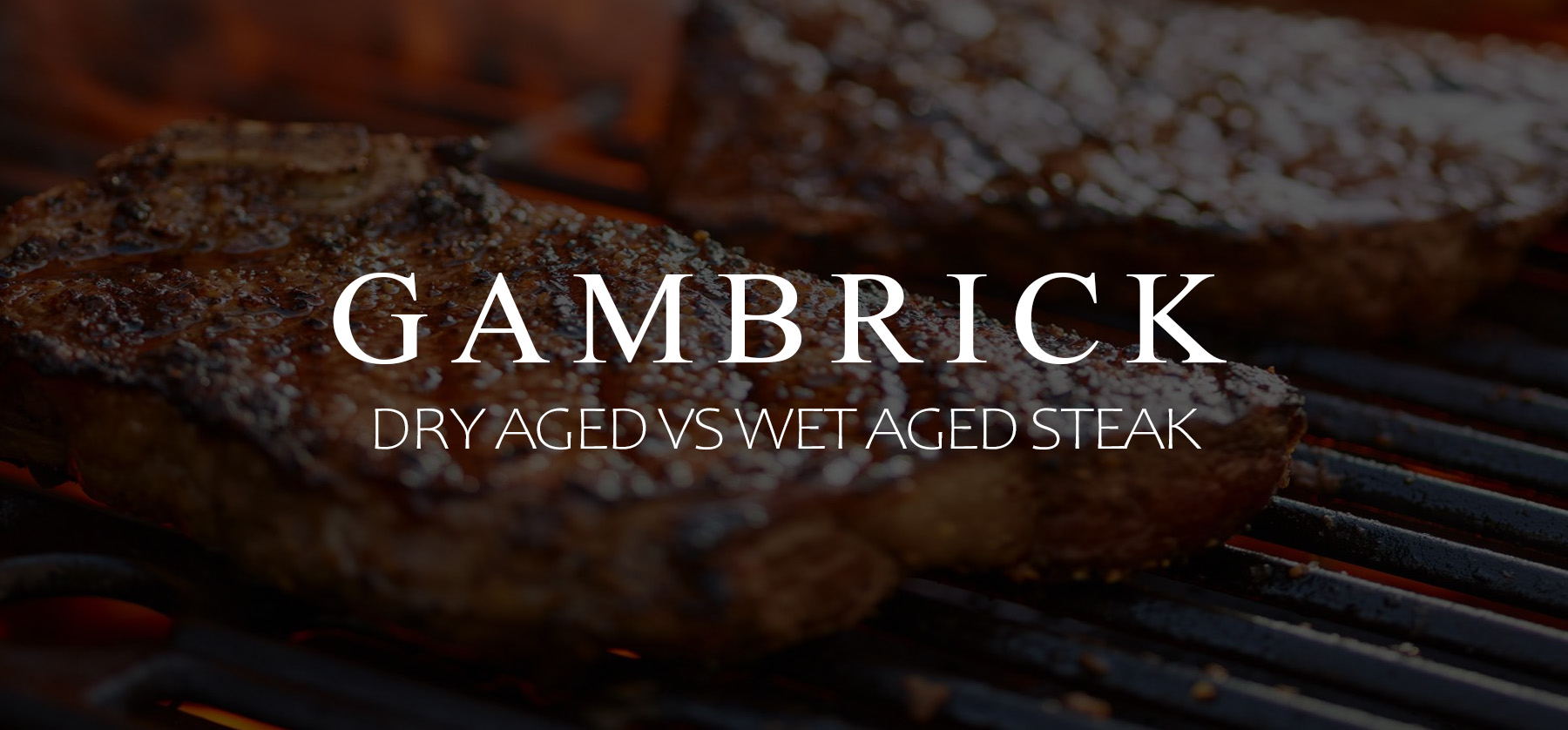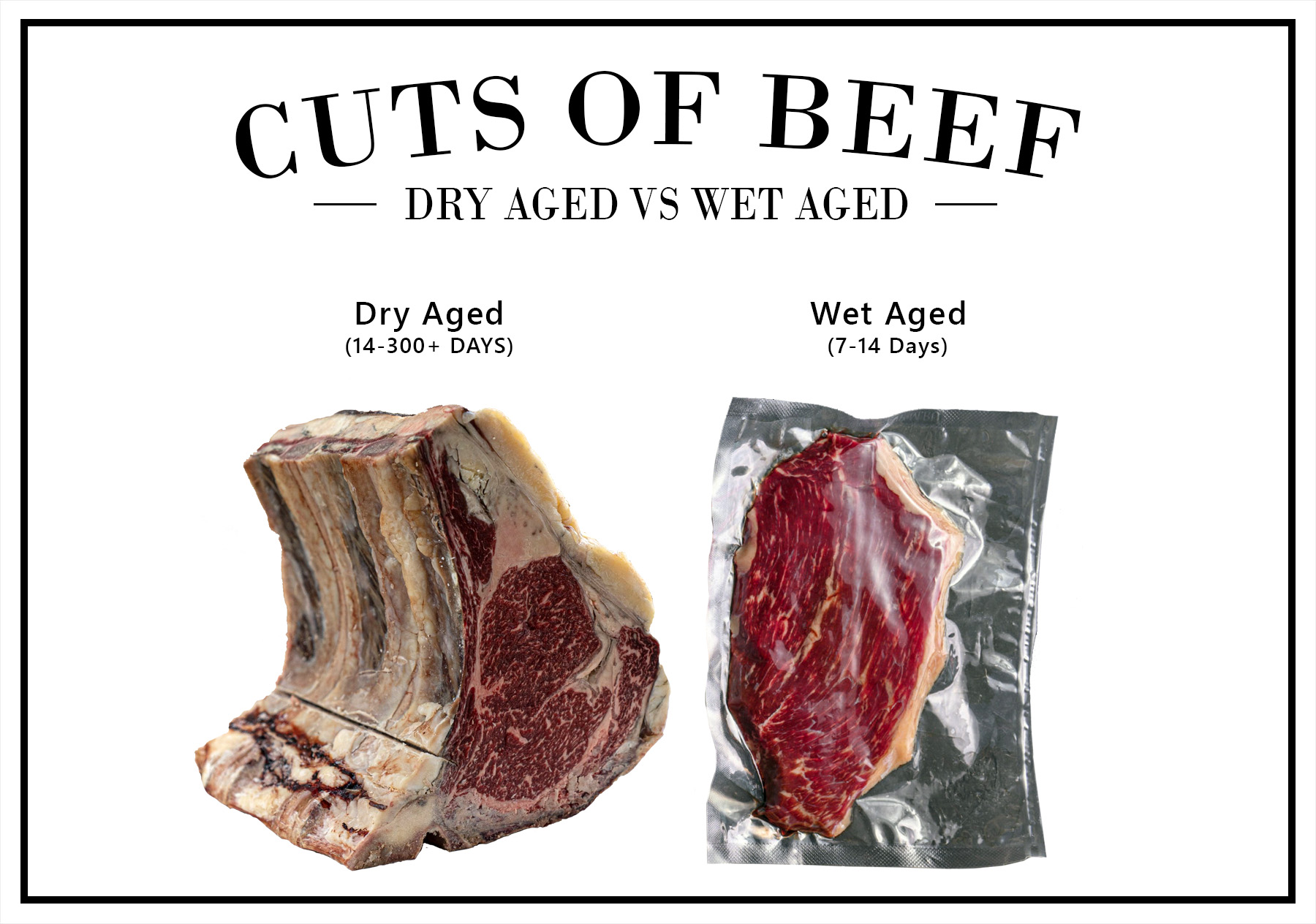Dry Aged Vs Wet Aged Steak
Aging beef tenderizes the meat and enhances flavors. If you’ve had dry aged steak you’ll know how much of a difference it makes. Flavors are deeper and meat is more tender. Even tough cuts can be improved by aging. But high quality beef, like filets, get so tender you can cut them with a fork. It takes time and money but the result is better meat. There are two main ways to do it, dry aging and wet aging. Dry aging is the older technique. It’s been used to age all sorts of meats and cheeses for centuries. Wet aging is a newer method that involves vacuum sealing in plastic bags. Both produce tender beef. So dry aged vs wet aged steak, which is better?
Aging is a way to enhance the steak. Dry aged beef is hung in the open air to dehydrate at a temperature just above freezing. This can also be done in a meat refrigerator. It’s left to age for weeks or even months. The steak builds a thick, moldy coating that’s cut away before cooking. Steakhouses often show off their dry aged steaks in glass cases so you can pick which one you want. Dry aging is a fantastic way to tenderize beef but should only be done by a professional. The process creates an earthy, nutty flavor. The longer it’s aged the more pungent the taste.
Wet aging is a newer technique where beef is vacuum sealed and refrigerated. Natural enzymes tenderize the meat as it ages. Wet aging only takes a few days, so it’s cheaper than dry aging. It’s also easier to do and can be done at home. The process produces a tender meat with little change in flavor. But the beef isn’t as tender as dry aged.
All Steak Is Aged
Every piece of beef you buy is somewhat aged. From the time a cow is butchered to when it hits the store, is sold and cooked at your home, is a form of aging. The processes that gets a steak from the farm to your plate takes time. How that time is spent helps determine the flavor profile and texture of the steak.
When you look at a shrink wrapped piece of beef in a supermarket that’s starting to turn a little brown or grayish, that’s aging. But this isn’t the aging process I’m talking about. This isn’t an example of dry aging or wet aging. This is just beef that’s sitting in a fridge too long. When you buy beef in a market, but it as fresh as possible.
Dry aging vs wet agings beef is a purposeful and controlled way to age beef to enhance it’s flavor and texture. Aging steak on purpose makes beef more tender and changes the flavor profile. Dry aged beef can become earthy, nutty and even a bit tart over time. Wet aged steak becomes more vibrant with an even fresher taste. Both make meat softer and easier to chew.
Differences Between Dry Aged vs Wet Aged Beef
Wet aged steak and dry aged steaks have a slightly different flavor and texture because of their aging processes. But both are more tender and flavorful then steak that isn’t aged. So either way you really can’t go wrong. Aging enhances the meat in just about every way. But it takes time and money to do it properly.
Dry Aged Steak has a flavor that’s both earthy and a little bit nutty. It’s sharper and more intense than a typical steak. When browned the taste is both meaty and robust with a great smell. Dry aged beef is extraordinarily tender because the aging process is so long. The meat fibers become softer and more moist.
Dry aged beef that’s been hanging for over a month can often develop a slightly tart taste similar to bleu cheese. I prefer a slightly dry aged steak that’s tender and more flavorful but hasn’t developed a tartness. About 2-3 week seams like the right amount of time for me.
Wet Aged Steak produce a fresher more vibrant flavor. It’s more tender than a regular steak and the flavor is enhanced but not really changed. Wet aging steak tastes better in leaner cuts of beef like a flat iron steak, where there’s less marbled fat. Beef cut for dry aging starts out much thicker than wet aged steak but loses mass during the aging process.
Both dry aged vs wet aged beef produce an excellent tender and juicy steak.
Dry Aging Beef
Dry aging is a slow process that’s designed to produce the most tender meat possible. It’s done by hanging beef in the open air. The meat is kept just above freezing temperatures to prevent microbial growth while enabling the drying process. If the meat were kept below freezing, its juices would freeze instead of becoming dry.
Beef can be aged for several weeks or even months. During this time, naturally occurring enzymes work on the muscles of the meat to tenderize it. The enzymes change the texture of the meat and redefine its flavor.
Dry aged steak produces the most tender beef you can eat and changes the flavor substantially. Dry aged flavors tend to be stronger. The steak becomes a bit nutty or earthy with a slightly bitter taste. The longer the beef is dry aged, the more powerful these new flavors become.
For all the benefits of dry aging steak, there are also a few downsides.
- You lose a lot of meat. The loss of moisture reduces the mass of the beef.
- The aging process ruins the surface of the meat. Water evaporation, bacteria and enzymes form a moldy crust on the outside that is eventually trimmed away before cooking. This also adds to the loss of meat.
- Dry aging takes time and is more expensive.
Despite the high price, many people love the flavor and texture of dry aged meat and are willing to pay the premium. Just about every high end steakhouse offers cuts of dry aged steak. Some costing thousands of dollars per filet.
Why Dry Age Steak?
There are three main reasons beef is dry aged.
- Moisture Loss: Dry-aged beef loses mass because of moisture loss during the aging process. Some say as much as 30% of its moisture is shed while drying. This is significant since most cuts of beef average around 75% water. This is a benefit because when water is removed from the beef, its flavor becomes more concentrated.
- Tender: Beef’s natural enzymes break down connective tissue and muscle fibers during dry aging. Certain fungal species like thamnidium, produce collagenolytic enzymes that contribute to the tenderness and distinctive taste of dry-aged meat.
- Flavor: Bacterial and enzymatic reactions and oxidation of fat causes the meat to go brown which changes its flavor profile.
Dry-aged beef requires an acquired taste. The longer it’s aged, the funkier the flavor. It’s kind of like aged cheeses in that way. Some love the flavor, and some prefer a steak that’s more mild.
One of the main flavor profiles of dry aged steak is umami. Other foods with umami profiles include mushrooms, truffles, strong cheeses, fermented and aged produces, and marmite. If you like these flavors you’ll probably love dry aged beef.
How Long Does Beef Get Dry Aged?
In most restaurants beef is dry aged in 15-28 days.Sometimes beef is displayed in a glass drying rack and tagged so you can see the cut and how long it’s been aging. It’s important to try different age ranges because the flavors will change over time. If it’s your first time trying aged beef, start with a cut that’s only been aged about 2 weeks. The flavor will be closer to what you’re used to but more tender.
You can buy steak that’s been dry aged anywhere from 45 days to over 400. This gets very expensive though and totally changes the flavor of the beef. Some cuts costing thousands of dollars.
What Temperature Should Beef Be Dry Aged?
Cuts are stored in refrigerated open air as they age. This process can be expensive because you have to keep the room between 34-36ºƒ with airflow to ensure there is no spoilage. Running fans over the meat is preferential. This helps prevent the meat from going bad.
Aging is a slow and controlled process that takes constant cold air. In ancient times, meat was aged below ground where temperatures are steadier and above freezing. Shafts were cut to allow fresh air flow over the meat. But today steak aging is controlled by using meat refrigerators. They keep temperatures steady and include fans that constantly blow cold air over the beef.
Wet Aging Beef
Wet-aging steak is a newer process that’s been around for less than 70 years. Mass production of plastic bags and vacuuming equipment are what makes the process possible.
Wet aged beef is first cut and portioned.It’s not like dry aged beef where you age an entire slab of beef. Wet aging is done a portion at a time individually. Each small cut is bagged and aged separately.
Once a piece of steak is cut, it’s immediately placed in vacuum-sealed bags. It’s kept at a low temperature just above freezing just like dry aged meat, except it’s not exposed to the open air. The wet-aging process typically lasts around 10 days. During this time, naturally occurring enzymes tenderize the meat.
Wet-aging is a faster process than dry aging. Because of this, enzymes don’t have enough time to change the meat as much as dry-aging. The result is more tender meat but not as tender as dry-aged steak. However, wet aged steak has a lot more moisture inside. This distributes flavors across the meat more evenly. Also, wet-aging doesn’t produce the acidity that dry-aged steaks have. Steaks you’ll find at local grocery store or butcher are typically sealed in plastic which is a form of wet aging. So a wet-aged steak tastes much more like a traditional steak most people are used to eating.
Wet-aging process is faster and cheaper. And because the meat is vacuum-sealed, there isn’t any weight loss. This makes the meat less expensive per pound but you still get the benefits of aging.
- Wet aged steak is more tender than normal steak but not as tender as dry aged.
- Has more of a traditional flavor than dry aged.
If you want a more tender steak with a traditional steak flavor, give wet aged beef a try.
How To Select Aged Steaks
When comparing dry aged vs wet aged steak, it’s important to consider the cut and size of the beef that’s being aged.
A thick richly marbled steak is better for dry aging. During the dry aging process, meat sheds a lot of moisture and shrinks in size. You need more than a single serving of beef. Generally an entire slab of beef, or at least large cuts, are hung, dried and cut before cooking. Dry aging also involves trimming the top moldy crust of beef prior to cooking which also shrinks it’s size.
A fairly lean and much smaller steak is better for wet-aged beef.Wet aging is done a single serving at a time. Essentially, the exact cut of beef you’ll be cooking is what gets wet aged. There’s no size or moisture loss so you don;t need a huge piece of beef.
Both aging processes produce a more tender steak but some cuts are better than other for a particular process. here are a few recommendations to try.
Dry Aged: Porterhouse, Bone-In Ribeye, and Bone-In Strip Steaks.
Wet-Aged: Filet Mignon, Flat Iron, Flank and Boneless Strip Steaks.
Keep in mind, dry aged steaks take more time to age and lose mass which makes them more expensive. They also get an earthy flavor the longer they age. Wet aged steaks taste more like traditional beef.
The Best Ways To Prepare Aged Steaks
Dry aged and wet aged steaks are both cooked the same way on either the grill, in a cast iron skillet or the oven. Generally, the best steaks are cooked simply with just pepper and salt for flavor. But you can add other seasonings, rubs or sauces if you like.
Let dry aged steak thaw at room temperature for at least 30-60 minutes before cooking. Let wet-aged steaks rest for around 30 minutes so it can reach room temperature. Don’t cook them right out of the fridge.
Sear both sides of your steak first with very high heat and then cook the inside on lower heat. I like to baste my steaks with butter in a skillet after searing.
Once your meat is ready to cook, follow these steps:
- Heat the grill or skillet as hot as possible.
- Coat each side of the beef with coarse pepper and salt.
- Sear each side for a minute or two. This creates a crispy, caramelized coating with grill marks. Juices are locked in when you sear the beef.
- Move the beef to lower heat and cook until ready. The time it takes depends on how you like your meat. I like to baste the steak in butter as they slowly cook inside.
- If you use a meat thermometer to cook beef, medium-rare is around 130°F.
- Remove the steaks and let them rest for around 10 minutes before eating.
Dry-aged and wet-aged steaks are both tender and juicy. But dry aged is definitely the more tender of the two. Although it’s flavor is different than traditional beef. With wet aged, you get a more tender steak that’s also cheaper but has a traditional beef flavor.
Which Is Better Dry Aged Or Wet Aged Steak?
Which is better, dry aged or wet aged steaks, depends on what you want out of your steak. They’re both great choices but for slightly different reasons.
Dry aged steak is more tender than wet aged because it can be aged for so much longer. But along with that tenderness comes a change in flavor. The aging process makes the steak taste nutty, earthy and in some cases a bit tart. Some love the taste but you may not. Dry aged is also a lot more expensive than wet aged, and it should be done by a professional in a meat refrigerator. There’s also some meat loss with dry aged due to moisture evaporation and the top moldy crust is cut off before cooking.
Dry aged can take weeks or months to finish while wet aged is usually done in 7-14 days. If you’re in a hurry, wet aged is the only choice.
Wet aged is more tender than regular steak but generally not as tender as dry aged because it doesn’t age as long. But because it’s only aged for a week or two, the taste remains pretty much the same as regular steak. For me this is a huge plus because I don’t like the taste of dry aged meat.
Another benefit of wet aged steak is that you can do it all by yourself at home. All you need are plastic bags and a vacuum sealer which aren’t that expensive. The cost of the machine is less than most dry aged steaks in a steak house. And you can do it again and again.
Why Dry Age Or Wet Age Meat?
The reason why steak is either dry aged or wet aged is tenderness and taste. Both meat aging methods make the steak more tender than a regular steak. Dry aged is the more tender of the two but both methods create a very tender steak. Dry aged steak should be done by a professional in a meat refrigerator but wet aging can be done at home.
Taste is another reason. Dry aged steak eventually takes on a nutty, earthy flavor that can even be a bit tart. It’s a flavor some steak eaters pay thousands of dollars for. Wet aged meat usually tastes just like a regular steak.
Dry Aged vs Wet Aged vs Regular Steak
| Type | Cost | Time | Taste | Tender | DIY |
| Regular Steak | $$ | None | Normal | Normal | Yes |
| Dry Aged Steak | $$$$$$$ | Weeks to Months | Nutty, Earthy, Tart. Taste grows stronger the longer it’s aged. | The most tender steak you can buy. | Generally No |
| Wet Aged Steak | $$$ | 7-10 Average | Typically no change in taste | More tender than a regular steak. | Yes |
Wet Aged vs Dry Aged Flavor
The flavor of dry aged steak changes depending on how long it’s aged. Over time, the outer crust of the steak because harder and often moldy. This part is cut off before cooking so you don’t eat it. The meat flavor profile becomes nutty, earthy and sometimes tart. Steak lovers pay thousands of dollars for meat that’s been aged for months and has a strong pungent flavor.
Wet aged steak isn’t aged for that long so the flavors don’t typically change. It tastes just like regular steak only it’s more tender. Wet aging can be done by yourself at home so it’s more about tenderizing the meat than changing the flavor.
How Long To Wet Age Steak At Home
Wet aging steak typically takes 7-14 days. During this time, the steak’s naturally occurring enzymes work to tenderize the meat.
Hard areas of connective tissue found within the steak are broken down which makes it easier to eat. Enzymes continue to work on the steak tissue for as long as it’s being aged.
This is done without losing weight through dehydration which is one of the main benefits of wet aging over dry aging.
If you don’t know how to wet age beef then do some research before you try. Temperature and humidity levels have to be tightly controlled during the process. I wouldn’t try it in a regular refrigerator. Bacteria can start to grow inside the bag which can make you sick.
If you do try it, don’t age the steak for too long. Some say wet aging can be done for much longer than 14 days but the chance for bacterial growth becomes higher the longer the aging process continues. Whenever I wet age steak I stick to around 7-10 days. By 7-10 days I usually get the tenderness I want so any more time would be a waste.
Wet Aged Steak Smell
Sometimes wet aged steak smells weird when you cut open the plastic bag. It’s normal for some smell to be there. It should go away once you throw away the bag and rinse the meat. But if it doesn’t go away or the smell is really strong, the meat has probably gone bad. I’d throw it out and try again.
After wet aged meat is removed from the bag and rinsed, it shouldn’t smell bad.
The Bottom Line
Now the you understand the similarities and differences between dry-aged and wet-aged beef. Which is better?
Typically, dry-aged steak is considered to have a higher quality because it’s the most tender beef you can get. More tender is almost always better, and many steak lovers claim the dry-aged flavor profile is superior to traditional beef. But the downside is price. Just about the only place you can find a dry-aged steak is a high-end steakhouse.It’s not really something you can do at home unless you have a meat refrigerator and know what you’re doing. If you want to try dry aged steak, start with a cut that’s only been aged about 2 weeks and expect to pay more than usual.
Wet-aged beef is more tender than a standard cut of beef with more moisture and a traditional beef flavor that many people love. Plus the price is much lower and you can do it yourself at home with plastic bags and a vacuum machine. If what you want is a tender steak that won’t cost a fortune without changing the flavor profile, try wet aged.
Summary: Dry Aged Vs Wet Aged Steak
Aging beef tenderizes meat and enhances flavors. If you’ve had dry aged steak you’ll know how much of a difference it makes. Flavors are deeper and meat is more tender. Even tough cuts can be improved by aging. But high quality beef, like filets, get so tender you can cut them with a fork. It takes time and money but the result is better meat. There are two main ways to do it, dry aging and wet aging. Dry aging is the older technique. It’s been used to age all sorts of meats and cheeses for centuries. Wet aging is a newer method that involves vacuum sealing in plastic bags. Both produce tender beef. So dry aged vs wet aged steak, which is better?
Dry aged beef is hung in the open air to dehydrate at a temperature just above freezing. This can also be done in a meat refrigerator. It’s left to age for weeks or even months. The steak builds a thick, moldy coating that’s cut away before cooking. Steakhouses often show off their dry aged steaks in glass cases so you can pick which one you want. Dry aging is a fantastic way to tenderize beef but should only be done by a professional. The process creates an earthy, nutty flavor. The longer it’s aged the more pungent the taste.
Wet aging is a newer technique where beef is vacuum sealed and refrigerated. Natural enzymes tenderize the meat as it ages. Wet aging only takes a few days, so it’s cheaper than dry aging. It’s also easier to do and can be done at home. The process produces a tender meat with little change in flavor. But the beef isn’t as tender as dry aged.
If you have any questions or comments about steak, email any time.




















